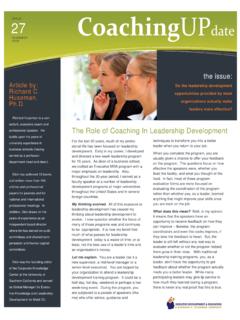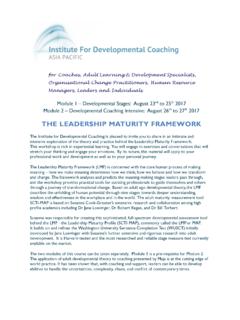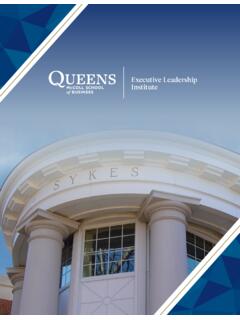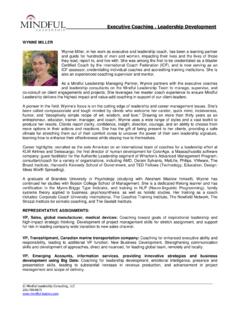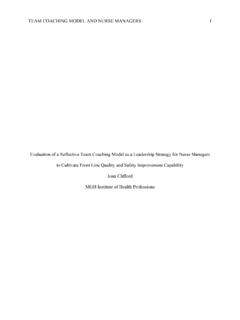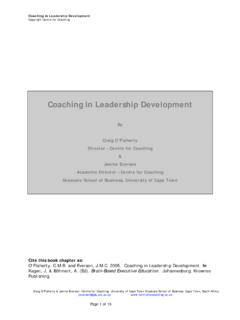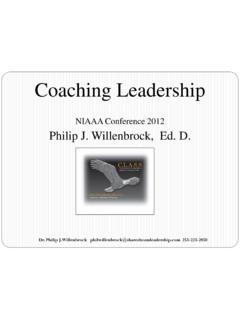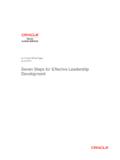Transcription of An Integrative Model for Executive Coaching
1 An Integrative Model for Executive CoachingJonathan PassmoreThe Office for Public Management,London, and University of East LondonExecutive Coaching has grown in popularity, butin spite of this growth, the use of sophisticatedapproaches appears limited. This article bringstogether a series of evidence-based approachesto build an integrated Model for executivecoaching, which can be described as Model uses the concept of working at mul-tiple levels with coaches; behavioral, cognitive,and unconscious. It combines these elementsinto streams, which the coach works acrossseamlessly. The Model recognizes the centralimportance of building a Coaching partnershipand the role of emotional intelligence in thisprocess with a focus on improving performanceat : Executive Coaching , integratedmodel, cognitive behavioral Coaching , humanis-tic Coaching , psychodynamic coachingThe past decade has seen a significantlygrowth in Executive Coaching with a corre-sponding increase in the number of aca-demic contributions (Grant, 2004; Kampa-Kokesch & Anderson, 2001).
2 In spite ofthis increase in writing and reflection, therange of Coaching models available tocoaches owes more to the experience ofcoaches with backgrounds in counselingand psychotherapy than those with a back-ground in business. We have seen the de-velopment of rational emotive behaviortherapy (Sherin & Caiger, 2004), psy-chodynamic Coaching (Rotenberg, 2000;Kilburg, 2004), solution-focused Coaching (Grant & Cavanagh, 2002), and cognitivecoaching (Neenan & Dryden, 2001). Incontrast, there have been few contributionswith a strong conceptual grounding basedwithin the fields of change or leadershipdevelopment. No Coaching models haveemerged from popular theories, such astransitional change (Bridges, 2003), orfrom developmental leadership models,such as emotionally intelligent leadership (Goleman, Boyatzis & Mckee, 2002). Anexception to this is the exciting contribu-tion of action frames theory (Cocivera &Cronshaw, 2004) and Laske s (1999) con-tribution on the theme of developmentcoaching.
3 This dearth of cross-fertilizationand the focus on transferring a single modelfrom its therapy origins to Coaching has leftcoaching without a holistic Model whichthe Executive coach can use as a guidewithin the business world. Further such sin-gle models fail to reflect accurately the trueeclectic practice which have developed inthe world of therapy (Smith, 1982;Mahalik, 1990; Arnkoff & Glass, 1992;Hill & Corbett, 1993).This article aims to begin the process ofdeveloping a Model which is designed forthe Executive boardroom rather than onethat has been transferred from the thera-pist s couch. Although it is not claimed thatthe Integrative Model is unique, the blendof elements provides a distinctive ap-proach. The Model is strongly evidence-Jonathan Passmore is a chartered occupa-tional psychologist and works for the Office forPublic Management. He has worked as a direc-tor and company chief Executive prior to becom-ing an Executive coach. He is the author ofExcellence in Coaching the Industry Guideanda contributor toThe Handbook of concerning this article shouldbe addressed to Jonathan Passmore, OPM, 252 BGrays Inn Road, London, United : 2007 by the American Psychological Association and the Society of Consulting Psychology, 1065-9293/07/$ : Psychology Journal: Practice and Research, Vol.
4 59, No. 1, 68 7868based, and it is hoped others will reflect onit and develop it could be argued that the primary ob-jective of Executive Coaching is to facilitateperformance enhancing behavioral changewithin the workplace. This view is widelyshared by writers (Levinson, 1996; Popper& Lipshitz, 1992; Thach & Heinselman,1999). However, many writers in the fieldimplicitly put the same amount of value onwell-being and self-regard as goals inthemselves. It is acknowledged that suchfactors are important, along side deepeningself-awareness and a stronger motivation toact. However, the primary measure of suc-cess of Executive Coaching is its impact onthe development of more effective work-place of the ModelThe Integrative Coaching Model (seeFigure 1) consists of six streams. The streams flow together in a seamless way,with the coach moving between streams inthe movement. Although the Model sug-gests a typical pattern of immersion, mov-ing clockwise, the pattern is not fixed andinstead responds to the moment to momentchanges observed by the coach in the roomand his developed intuitive first stream (developing thecoaching partnership) draws on workfrom the humanistic tradition.
5 The secondstream (maintaining the Coaching part-nership) draws on both emotional intelli-gence and aspects from the psychody-namic tradition. The coach needs to starthere to create an effective relationshipbetween the coach and coachee, and tomaintain this throughout what we call the Coaching partnership. Without this ini-tial investment in the relationship,progress on change will be difficult. Thework of maintaining the relationship con-Figure Coaching Psychology Journal: Practice and ResearchMarch 2007tinues through the Coaching experience asthe coach pays attention to his interac-tions with the following three streams, where thefocus of change occurs, build on Schein swork (1985) on organization identified five levels which he sug-gested exist within organizations; artifacts,behaviors, mind sets, emotional ground,and motivation. These levels can equally beapplied to the individual within the third stream (behavioral focus) is atthe core of all Executive Coaching : behav-ioral change.
6 The aim is to support behav-ioral change and to achieve this throughdeepening the coachee s problem-solvingand planning fourth stream (conscious cognition)draws upon cognitive behavioral coachinginterventions. The aim of the work in thisstream is to deepen the coachee s under-standing of the relationship between theirthoughts and their fifth stream (unconscious cognition)focuses on the cognitive processes whichare outside of conscious awareness. Theaim of the coach in this stream is to deepenthe self awareness of the coachee by bring-ing into conscious awareness aspects ofthought and motivation that inhibit theireffective behavioral performance. Thisstream draws upon the psychodynamic tra-dition, but can also uses techniques frompsychological specialist approaches includ-ing motivational interviewing (Miller &Rollnick, 2002; Passmore & Tinwell, inpress) and eye movement desensitizationand reprocessing (EMDR; Shapiro & Forrest,1997).A sixth stream surrounds the Model .
7 It isthe cultural context in which both coachand coachee operate. The coach will con-sciously hold an awareness of the bound-aries and codes which this stream imposes,which may be ethical, legislative, or working in each of these streams,the coach should maintain in his or hermind the overall goal of helping thecoachee enhance his work Coaching Partnership: Streams 1and 2 Before any Coaching to enhance perfor-mance can begin the coach needs to build arelationship with the coachee. The poten-tially close and affirming relationship ofcoaching demands mutual respect and trustbefore deeper work can begin. Althoughthese are central to establishing a success-ful relationship, this is not enough by perspective that Roger s (1957) con-ditions are necessary but not sufficient isone shared by other writers (Patterson,1984). The coach also needs to continuallywork on this relationship maintaining thecoachee s trust and constitutes the necessary condi-tions for the formation of such a relation-ship?
8 This question has in part already beenanswered for us by the work of humanisticwriters such as Rogers (1957). He sug-gested that a series of elements needs to bein place for a successful therapeutic alli-ance to be formed. It can be argued thatthese relationship elements are of equal im-portance in any work with individuals inthe consulting world. The closer the rela-tionship and the smaller the group, thestronger the investment the consultant(coach) needs to make in the relationship. Itis also at the start of the relationship whenthe relationship is most fragile that thecoachee is asking themselves, Do I trustmy coach? , Do I like my coach? , and Do I value what my coach is offering? Although Roger s six conditions areuseful for the Executive coach to under-stand, the Executive coach in the 21st centuryneeds to take account both of metasearchover past 50 years since Roger s originalwriting (Patterson, 1984) and also the corpo-rate environment in which they Psychology Journal: Practice and ResearchMarch 2007 Five elements are critical to help build a Coaching partnership between coach coach needs to hold a positive selfimage.
9 The coach needs to believe he isable to work constructively in an adult re-lationship within another person. Thismaybe viewed as the I m ok part of thetransactional analysis (TA) second element is a belief in thecoachee: positive regard for the belief by the coach that the coachee, asan adult, is able to find, through appropriatesupport and challenge, answers to their ownproblems. This may be viewed as the you re ok part from third element is the ability of thecoach to display empathy during the coach-ing relationship. The coach needs to dem-onstrate during Coaching that he under-stands and cares about the fourth element is that the coach needsto act openly and honestly in his relation-ship with the coachee. To be able to expresswhat he feels in an open and honest way, incontrast with feeling or thinking one thing,and communicating something else. Suchduplicity will leak out and will damage therelationship. This is not to say the coachcontinually expresses his feelings, butrather manages this process sharing in-sights or views only when this is judged tobe of value to the final element which the coach needsto pay attention to is the focus.
10 The coachneeds to ensure the coachee is at the heartof what the coach does. This means thecoach uses questions, challenges, support,and contributions with the sole objective ofmeeting the needs of the can be argued that the result of thesedaringly simple responses enables a warm,trusting, and open relationship to relationship in which the coachee is ableto share the full truth of his or her percep-tion and feels accepted rather than is also a relationship in which the coachis able to gradually increase the level ofpersonal challenge without devaluing theaffirming nature of Coaching . I have notedearlier that while Rogers argued that such arelationship by itself has a positive effect,this was not fully supported by counselingresearch. This view is also supported by myown research (Passmore, 2006) on thevalue which executives experience fromcoaching. The finding suggest that althougha positive Coaching partnership can helpbuild the coachee s self esteem, by itselfthis is not enough for executives to meettheir expectations or a relationship has been formed, therole of the coach is to maintain this rela-tionship.
